There are seven noted species of turtles in Nevada. Only two of these are native species; the Desert Tortoise, Nevada’s state reptile, and the Western Pond turtle.
The other five species are non-native turtles, which may have been introduced as part of conservation efforts, or unsafely released into the wild from captivity. Nevada’s non-native turtle species include the Painted turtle, the Sonora Mud turtle, the Red-eared Slider, the Common Snapping turtle, and the Texas Spiny Softshell.
We’ll take a look at each species below, providing some facts as well as descriptions about their appearance, habitats, and diet. Here are the seven species of turtles in Nevada.
Native turtles in Nevada
1) Desert Tortoise

- Family: Testudinidae
- Scientific Name: Gopherus Agassizii
- Other Names: Mojave Desert tortoise
- Adult Size: Between 10 and 15 inches
- Weight: Between 8 and 15 pounds
- Lifespan: Between 60 and 80 years
- Conservation Status: Threatened
- Clutch Size: Between 4 and 8 eggs, up to three times a year
- Average Price Range: Between $200 and $300 (require a permit)
- Recommended Books: Keeping a pet tortoise by A.C. Highfield
The Desert tortoise is one of the only native species in Nevada, and is the official state reptile. Sadly, this keystone species is also threatened, mainly due to habitat loss. Desert tortoises are protected in Nevada.
Desert tortoises have large domed shells which range from brown to green. Their scutes have light patches. They are relatively inactive for most of the year, digging and sheltering in earth burrows or caves. Desert tortoises prefer desert areas as well as dry grasslands.
They are herbivores and mainly feed on grasses, wildflowers, and cacti and succulents in the summer months.
2) Western Pond Turtle
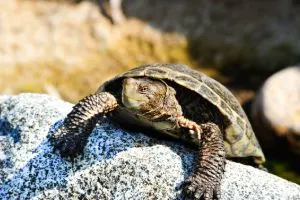
- Experience Level: Intermediate to Expert
- Family: Emydidae
- Scientific Name: Actinemys Marmorata
- Other Names: Pacific Pond turtle
- Adult Size: Between 6 and 8 inches
- Lifespan: Between 30 and 50 years
- Average Price Range: Around $500
- Where To Buy: theturtlesource.com
The Western Pond turtle is known to be a native species in Nevada, although sightings are exceedingly rare. They are Nevada’s only native freshwater turtles. Surveys are being undertaken in Carson Valley to determine current numbers.
With dark brown to olive shells, Western Pond turtles sport flecked light to cream markings. They have yellow plastrons with dark markings as well as brown spotted skin.
Western Pond turtles are an aquatic species inhabiting lakes and ponds and sometimes brackish waters. They are omnivores, mainly consuming fish, worms, insects, and occasionally plants. They are very shy and secretive.
Non-native turtles in Nevada
Five species of turtles in Nevada are non-native. These specimens may either have been introduced through official conservation efforts or may be former captive pets that have been unsafely released into the wild. Here are the five non-native species of turtles in Nevada.
3) Sonora Mud Turtle
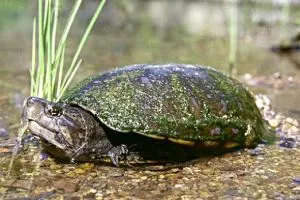
- Experience Level: Intermediate
- Family: Kinosternidae
- Scientific Name: Kinosternon Sonoriense
- Other Names: Sonoyta Mud turtle
- Adult Size: Between 5 and 7 inches
- Lifespan: Between 30 and 50 years
- Average Price Range: Between $150 and $295
Sonora Mud turtles have been introduced into Nevada. They are a threatened species thanks to unnatural changes to their preferred habitats. They prefer rocky areas with slow moving waters, and prefer soft substrates where they can burrow.
These Mud turtles have brown to olive domed shells, split by three horizontal keels. Their plastrons are yellowish. Their skin is speckled with green and black, with webbed feet. Their shells also have scattered black dots.
Sonora Mud turtles are omnivores, mainly eating mollusks, invertebrates, amphibians, small fish, and sometimes carrion. They will also occasionally eat plants and other vegetation.
4) Western Painted Turtle
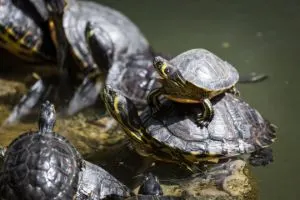
- Experience Level: Beginner
- Family: Emydidae
- Scientific Name: Chrysemys Picta Belli
- Other Names: N/A
- Adult Size: Between 4 and 10 inches
- Lifespan: Between 30 and 50 years
- Average Price Range: Between $20 and $50
Western Painted turtles are the largest of the Painted turtle subspecies, and are non-native to Nevada, possibly introduced from unsafe release from captivity. They are a popular pet turtle species.
Mainly aquatic, Painted turtles like to stay near the water and bask. Painted turtles are omnivorous and mainly eat mollusks, frogs, and underwater invertebrates. They must swallow their food in the water.
Western Painted turtles have olive green shells, often edged in colors ranging from yellow to red. Their faces also have yellow stripes. They are distinguished from other Painted turtle subspecies thanks to darker plastrons.
5) Red-eared Slider
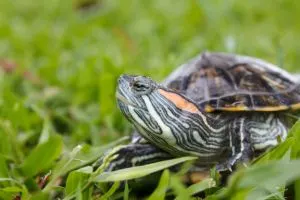
- Experience Level: Beginner
- Family: Emydidae
- Scientific Name: Trachemys Scripta Elegans
- Other Names: Water Slider turtle, Red-eared Terrapin
- Adult Size: Between 6 and 8 inches
- Lifespan: Between 20 and 40 years
- Average Price Range: Between $15 and $50
- Recommended Books: Red-eared Slider Turtle Owners Manual by David Donalton
Red-eared Sliders have been sighted in scattered river areas in Nevada. They are one of the most popular species of pet turtle on the market, and often get released unsafely in non-native areas. They are considered an invasive species in many regions.
These Sliders commonly have an olive green shell, with yellowish striped markings on their scales. Their heads are usually a darker color, with yellow band markings and red patches just behind their eyes.
Red-eared Sliders prefer warm, slow-moving waters such as rivers and lakes. Their omnivorous diet consists of small fish, aquatic invertebrates, and underwater vegetation.
6) Common Snapping Turtle
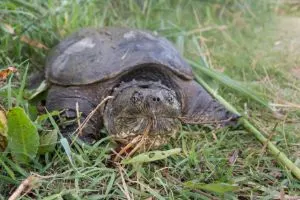
- Experience Level: Intermediate to Expert
- Family: Chelydridae
- Scientific Name: Chelydra Serpentina
- Other Names: Common Snapper, Eastern Snapping turtle, Snapper
- Adult Size: Between 8 and 20 inches
- Lifespan: Between 30 and 50 years
- Average Price Range: Between $20 and $40
- Recommended Books: Snapping Turtle Pet Owners Guide (Ben Team)
Common Snapping turtles are a large, freshwater species that have been spotted in Nevada. They are aggressive and can pose threats to endemic wildlife if introduced unsafely into non-native regions.
Common Snapping turtles have distinctive hooked beaks. They usually have dark brown or green ridged shells, with strong claws and long tails bearing saw-toothed ridges. They prefer areas of permanent, deep water.
Common Snapping turtles are nocturnal omnivores and mainly eat amphibians, fish and even smaller turtles. They have even been known to eat small waterbirds if they get close enough. Occasionally they will also consume plants.
7) Texas Spiny Softshell Turtle

- Experience Level: Intermediate to Expert
- Family: Trionychidae
- Scientific Name: Apalone Spinifera Emoryi
- Other Names:
- Adult Size: 5 to 9 ½ inches for males, 7 to 17 inches for females
- Lifespan: Between 20 and 50 years
- Average Price Range: Between $70 and $280
Texas Spiny Softshell turtles are found around the Lake Mead area in the south of Nevada. They are fast swimmers and can be aggressive if caught or handled. Their shells feel like sandpaper to the touch.
Texas Spiny Softshells have a leathery shell pancake-shaped shell, bearing white spot markings. They have long, tapered beaks with crescent-shaped nostrils which they use to breathe while buried in the sand and awaiting prey.
Texas Spiny Softshells are carnivores and will feed on any crustaceans, insects, and mollusks that swim past their hiding place. They then grab their prey in their mouths.
Wrapping Up
In this list we have covered seven turtle species that can be found in Nevada. Only two of these species, the Desert tortoise and the Western Pond turtle, are true native species. The Desert tortoise is Nevada’s beloved state reptile.
Five species have also been introduced to Nevada, either as captive releases by pet owners or through conservation efforts. Some of these species, like the invasive Red-eared Slider, could pose serious problems for Nevada’s native turtles.
What did you think of our list? If you’d like to discuss these turtles in more depth, or if you are thinking of obtaining one as your next pet, please comment below!
Other nearby states
